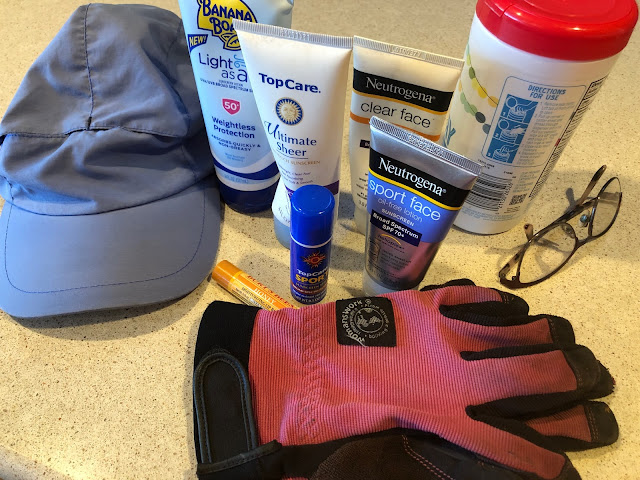Now that planting weather has arrived, I want to rush outside first thing, to enjoy the early morning air and the birds' delighted chirps. But it's worth the time involved to prevent injury by taking some easy measures:
1. Use sunscreen. Arms, neck, back of calves, bridge of nose -- anywhere that's not going to be covered by clothing gets a nice layer of greaseless sunscreen. The American Academy of Dermatology recommends using a product with broad spectrum protection, an SBF of 30 or higher, and water resistance. To avoid breakouts, I use a strong one specifically for faces on my face, neck and ears. Also apply some lip balm, preferably with moisturizer or protectant. That's exposed skin, too.
2. Wear a hat. After trying all kinds of gardening headgear -- straw, cloth, nylon, strings or not, brimmed or not -- I settled on a personal favorite: a washable synthetic baseball cap with a large bill, anchored with bobby pins. It soaks up sweat and doesn't get knocked off (or strangle me) if I brush past a tall shrub or tomato plant. I have several that I rotate through during a busy gardening week. But everyone has different needs; the point is to cover your head and shade your eyes a bit.
3. Don a pair of sunglasses or safety goggles. Ever accidentally gotten dirt in your eye? How about a pointy leaf? I've done both, and wound up seeking medical care in both cases. Whatever was in that soil gave me a nasty case of pink eye. The pointy leaf poked the corner of my eyelid and it hurt like heck for days. Didn't look so great, either. Now I always have something over my eyes when I'm outdoors. Goggles are especially important if you're working on something over your head, or you're running a lawnmower or power tool.
4. Use gloves. Keep your hands clean and protected, especially when using soil amendments, fertilizers and sharp tools. I prefer washable ones with a velcro cuff and reinforced fingertips, but again, this is personal preference. If you're working with roses or anything else thorny, a longer leather cuff would be more protective.
5. Choose closed-toe gardening shoes. When it's hot, it's tempting to garden in sandals or flip flops. But you might live to regret it, especially if working with pruning shears or another sharp tool. My big toe was stapped once by a sharp piece of bark mulch, and that was enough to convince me to wear my Sloggers or some clogs in the garden at all times. (I wear them with short white cotton socks, which keeps them from sticking to my sweaty feet.)
Once you're covered, do those hard-working muscles a favor: Stretch. Just a gentle stretch to limber up shoulders, biceps, legs, feet, ankles. Gardening is a full-body exercise! Check YouTube for easy warm-up moves.
And do your back a favor: Lift or dig using the strength in your legs. You'll get better leverage anyway, and you won't throw your back out.
Now before tackling that vegetable bed full of weeds, gather these and you'll be set for a long day of gardening:
-- Bottle of cold water. We get busy in the garden and forget we need water regularly just like the plants do. Keep something to drink nearby so you don't get dehydrated.
-- A container of wet wipes. Clean your hands, wipe your brow, clean the dirt off that thorn prick -- lots of reasons to keep them nearby.
-- An old, clean bath towel. Folded, it makes a nice kneeling pad that won't disintegrate like those foam things. Or you can wipe your tools on it.
-- Basket or bucket for the tools you're using right now. Everything goes back in when you're done -- no stepping on a forgotten tool later.
Happy and safe gardening!

